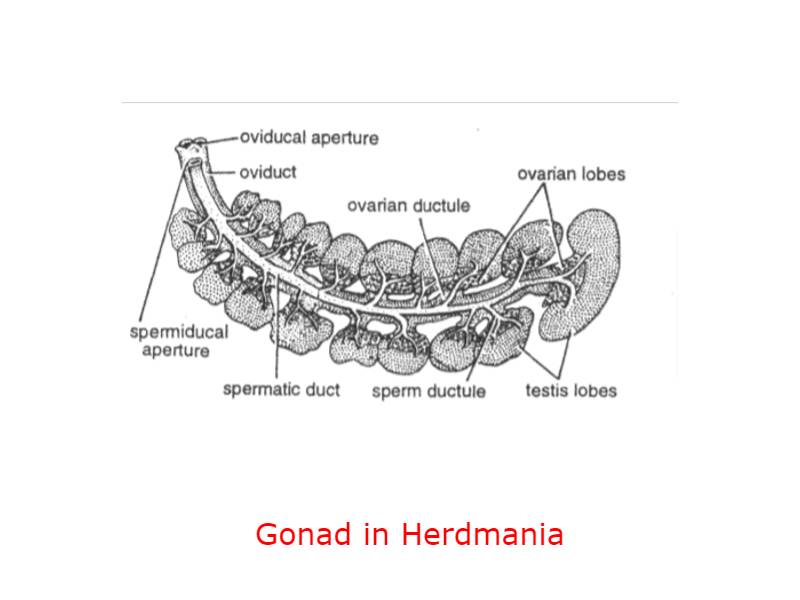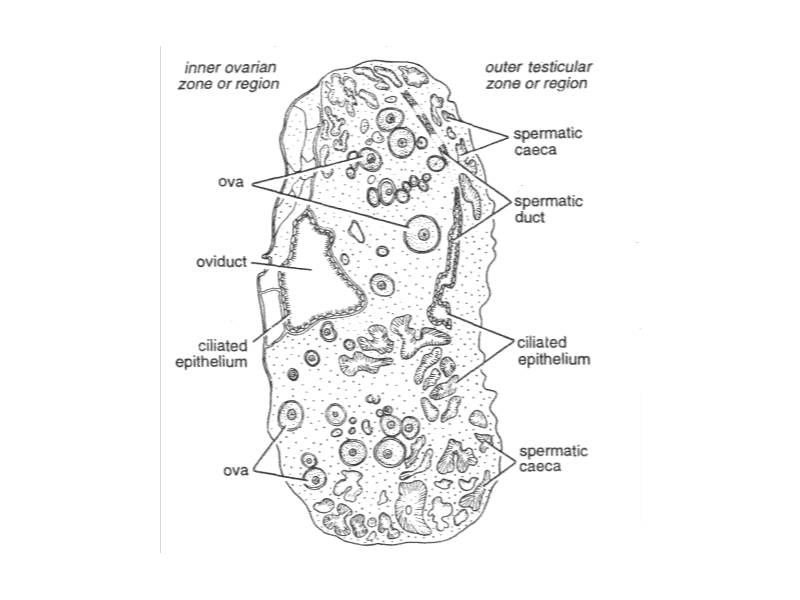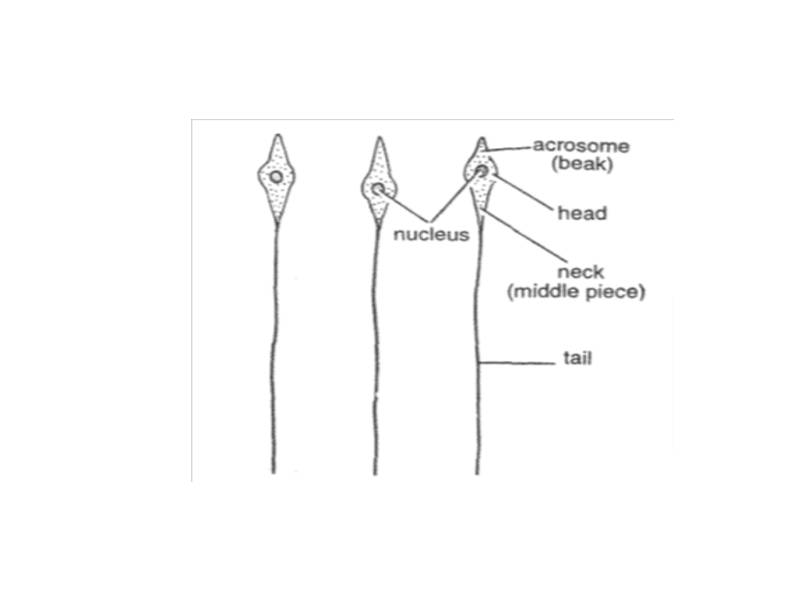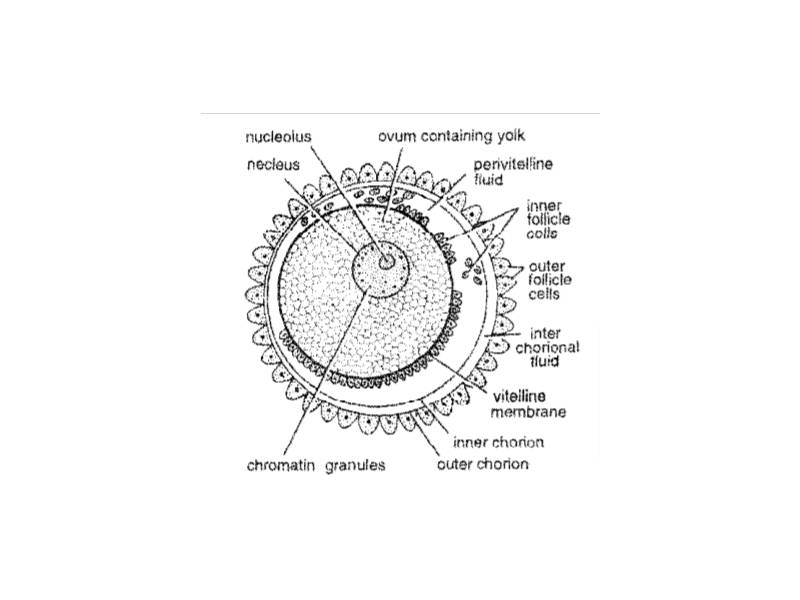Herdmania is a hermaphrodite animal, with both the male reproductive system and the female reproductive system present in each individual animal. But male and female gametes do not become mature simultaneously, Herdmania is protogynous so only one individual Herdmania is not able to reproduce, self-fertilization is not possible, two partners are required for fertilization.
Table of Contents
Reproductive System of Herdmania:
The reproductive system in Herdmania has paired gonads that produce two types of gametes that comes outside the gonoducts. Now we will discuss the structure and function of gonads and gonoducts which method of fertilization.
Gonads:
In the mantle layer, two gonads are embedded which bulge out in the atrial cavity the position of the two gonads is not side by side. The right gonad present dorsal to the pericardium and the left gonad is present within the intestinal loop.
In Herdmania each gonad is lobulated and elongated around 3 cm long, 1 cm wide and around 3 mm thick, gonad is hermaphrodite in Herdmania. If we notice a gonad then we will find a central axis, rounded or oval lobes of the gonad present in two sides of the central axis in two-row and at the top of the central axis a bean-shaped lobe present.
Each lobe is differentiated into two parts, the peripheral red coloured cortical regions represent the testis part and the inner medullary pinkish small portion represent the ovary part. The red testis portion of each lobe has several tubules in a compact manner known as spermatic caeca. Inside the lumen of the spermatic caeca germinal epithelium is present which takes part in the development of spermatozoa, spermatogonia and spermatocytes.

The medullary pinkish ovary region of each lobe has several ovary follicles. Due to those follicles, the surface of the ovary portion of each lobe appears lobular, inside each lobe in the ovary region have ova in different stages of development.
In Herdmania each lobe in the gonad have both female ovary part as well as male testis part, due to this coexistence of both male and female gonads, gonad in Herdmania is known as the ovotestis gland or hermaphrodite gland.
Gonoducts:
In each gonad, several rounded or oval lobes are present on two sides of the central axis and the terminal gonad is bean-shaped, all the lobes in the gonad contribute to the gonoduct. In each lobe of the gonad, the peripheral large cortical ovary portion produces a wider duct known as ovarian ductules, all the ovarian ductules from each lobe fuse together to form a common wider oviduct.
The small medullary testis region of each lobe in the gonad forms narrower spermatic ductules and all the spermatic ductules fuse together to form a common spermatic duct. Spermatic duct and oviduct run along the central axis and after a small distance, they open into the cloaca independently. The spermatic duct is much narrower than the oviduct and the narrow spermatic duct run inside the lumen of the wider oviduct.

At cloaca, the oviduct open outside through the oviducal aperture while the spermatic duct open outside at cloaca through the spermiducal aperture. Inside the lumen of the oviduct and spermatic duct epithelial is ciliated.
Gametes in Herdmania:
Male Gametes or Spermatozoa in Herdmania:
The small pinkish coloured inner or medullary region of each gonad lobe forms spermatozoa or sperm. Sperm cells are microscopic and have three parts, a broad head, a narrower neck or middle piece and a long slender tail.

The broad head has a nucleus and at the apical region, it has a cap-like structure acrosome and based on the size of the acrosome as compared to the size of the head, spermatozoa in Herdmania are three types, in one type acrosome is same in size as that of the head, acrosome is smaller than the size of the head and third type have larger acrosome as compared to the head.
Female Gametes or Ova in Herdmania:
The large red coloured cortical or peripheral region of each gonad lobe form ova or eggs, mature eggs is around 0.3 mm in size. The large ovum or egg cell has a conspicuous eccentric nucleus, cytoplasm rich in yellowish yolk and the membrane have three layers, vitelline membrane, inner chorion and outer chorion.
The vitelline membrane is thin and formed by the secretion of ova and the two chorionic membranes formed due to the secretion of follicular cells of the ovary. The space between the vitelline membrane and the inner chorion membrane is filled with perivitelline fluid. The space between two chorion membranes is filled with inter-chorionic fluid.

In the ovum two types of follicular cells are present, inner follicular cells and outer follicular cells both have some important functions. The outer surface of the vitelline membrane has inner follicular cells, most of which are attached to the outer surface of the vitelline membrane. But some inner follicular cells are present in the perivitelline fluid which takes part in the nutrition of the egg and secret some enzymes which help in the digestion of the chorion membrane during the hatching of the egg.
The outer surface of the outer chorion membrane have outer follicular cells, they are vacuolated and help in floating in the water.
Fertilization in Herdmania:
Herdmania is hermaphrodite, both male and female gamete are produced in the same individual but self-fertilization is almost absent. Because Herdmania is a protogynous type, the ova part of each gonad lobe become mature first but the testis part remains unmatured. Gametes come outside of the body through atrial aperture then fertilization occurs inside water so fertilization is external and cross-fertilization in. Herdmania.
Reference Habitat and Habits of Herdmania
Detailed Information on
Habitat and Habits of Herdmania
External Morphology of Herdmania
Mantle Viscera and Coelom of Herdmania
Hi Everyone!!! Welcome to Imaluop. Imaluop always try to learn some new and he want to share to other people. Here we will try to learn various topics on Science, specially on Biological Sciences.